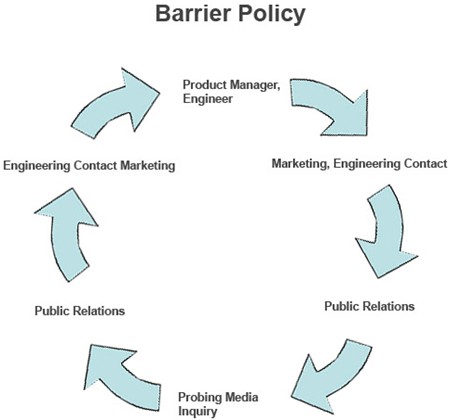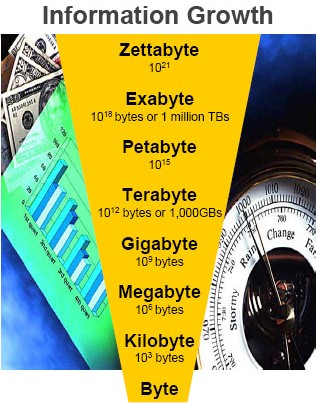First of all, if you're reading this article, you likely don't have these problems. But... you do know of companies and PR people who suffer from this malady.
We know that in theory corporate policy is to encourage creative thinking and growth. The communications policy is to quickly and accurately support all of your audiences. In fact, you're encouraged to think of new ways to efficiently and effectively accomplish that goal... as long as it follows corporate policy and conventional wisdom.
Let's examine three of these conventional wisdoms.
1. Public relations should be the sole spokesperson for the company
The more mature the company, the more mature the PR policy. Unlike business processes and procedures, as well as product lines, that are constantly evaluated regarding their value to the company and the consumer, PR policy is seldom scrutinized. Few departments look closely to see whether old efforts, measures, and controls make sense in today's environment.
Many monolithic firms have a clear policy that conceals marketing, product, and engineering management from the press. Rather than provide these knowledgeable people with adequate editorial contact training and guidance, policy dictates that all queries be centrally managed, filtered, and controlled.

In an era of global communications, some still focus on managing, even manipulating news coverage.
In this scenario, the probing press-type explains the problem, question, issue to the PR person. He or she will interpret it to one or more of the internal contacts, who will then filter the query to someone else who will provide an answer (or partial answer). This will be passed to the PR person, who will then provide the information to the member of the media.
If only part of the answer is provided, or if it stimulates an added question or clarification is needed, the cycle begins again.
At some point, the media person either forgets the initial question or is on deadline so he/she goes with the best information at hand... no matter how weak.
It is difficult to understand in today's instant-access environment how gatekeepers can survive when it is the facilitators and enablers who are important to an organization's success.
In an Internet-connected world, good and bad news will not be tethered.
2. PR should develop, run, and manage all blogs
The funnel concept worked well prior to the Internet. It even sounds good—in theory—today.
But the problem?
The Internet made the world accessible to everyone in the company.
IBM has tens of thousands of employee-to-the-world blogs. Microsoft has tens of thousands. HP has tens of thousands. Even small and midsize firms often have 10 or more blogs that are added to and read every day.
In addition, a few corporations have initiated public blogs. The success has been mixed because of management's ability to deal with full, complete, and open discussion.
To stem the tide of consumer complaints, Dell started a blog to communicate more effectively with customers and partners. The faintly veiled PR effort was quickly taken to task as being nothing more than an outbound publicity shill for the company. Management quickly turned the project into an open effort to communicate solid information and ideas while inviting unfiltered feedback.
Sanctioned or non-sanctioned, pro or anti company/policy, the blogs exist and have their audiences. Depending on the tone and substance of the employees' blogs, they have gained credibility with the global community.
Information and ideas flow smoothly in both directions.
Short of firing bloggers for moral or professional/business misconduct, there is little public relations or management can do to stem the blogging tide. In many instances, the blogs humanize the organization. As long as there is a healthy balance of positive and negative comments, observations, and ideas, they enhance the company's image and credibility in the marketplace.
Doing away with the blogs and individuals is seldom practical.
Apple silenced "The Secret Diary of Steve Jobs." Too bad. But it resurfaced in a much diluted form—fakesteve.blogspot.com.
Mini-Microsoft, the unauthorized Microsoft blog (minimsft.blogspot.com) does a superb job of humanizing the company. Congratulations!
The best approach is to work with the bloggers, providing information, background, and general/legal guidelines they should consider regarding their daily Internet diaries.
Wise/credible bloggers balance their company/business messages—pro and con.
Wise PR people train and work with the bloggers providing guidance, information, and assistance.
3. New products, new services require an editorial tour
While our industries are entering a period of dramatic innovation and disruption, some PR concepts are difficult to abandon. Not the least of these is the sacrosanct product press tour.
The press tour used to be a vital part of the product introduction process following several years of product development. There were a few key press locations—New York City, Boston, Washington D.C., San Francisco, Montreal.
Downsizing, media expansion/consolidation, remote offices, contract specialists, and the crunch of producing more content in a shorter period of time has affected companies, agencies... and media outlets.
A few firms have developed a new approach to producing long-term success with an accumulation of ongoing short-term successes.
This was crystallized at a recent conference on living with and managing change:
- The universe of information is simultaneously expanding and contracting
- 1 in 4 people have been in their job less than a year, and 1 in 2 less than 5 years
- The top 10 jobs in 2010 didn't even exist in 2004
- An average week of NY Times contains more information than people obtained during their entire lifetime in the 18th century

The speed of technology change shows no sign of slowing down. Instead, it is accelerating. Products used to enjoy a lifecycle of one to two years. Today that has shrunk to three to six months.
Product roll-outs need the same sense of urgency.
Time, not talent, for media types is a precious commodity.
Conventional media have been reduced to almost skeleton staffing, and these individuals now carry out double and triple duty. They write for their print or radio or TV outlet. They have their online site and often a blog or two.
The conventional media aren't alone, as new outlets find audiences on the Web.
News outlets, businesses, and individuals generate more than 1.5 exabytes of data and content each year. Soon, we will be sending 10 trillion bits over a single Internet optical fiber every second.

More efficient, more effective, more creative means of launching products and services have to be implemented beyond the tired old standby—the static press release. For example:
- Web-enhanced individual conference calls enable company spokespersons to "meet" with as many as 10 editors, reporters, and analysts a day. The combination of phone discussion and online presentation facilitates the dissemination of complete and accurate information as well as individualized news gathering.
- One of the most effective approaches we have used in recent years has been developed in conjunction with the management of VPO (Virtual Press Office). Introduced years ago to help companies and media people eliminate paper at every tradeshow, VPO has been remarkably open to other online applications of its news/information delivery service.
The media/research people pre-qualify themselves online and indicate their product interest areas. They are already predisposed to receiving your information. Even when we have met with people at a tradeshow, VPO's reports often show that these people obtained additional company/product information.
Based on this observation, we developed an added use of their service. With management's assistance we started with a conventional online product roll-out press kit—release, backgrounder, presentation, illustrations. Then we added a downloadable video presentation and demonstration. VPO sent details to its 6,000+ registered press representatives.
The first effort attracted 300 members of the media to the presentation. The second roll-out package was accessed by more than 800 members of the media.
Raw numbers don't disclose much. But with each product roll-out, more than half of the individuals requested review product, used the download video as an information refresher, and provided clients with coverage around the globe.
Making all of the information, including the video, available to the media regardless of clock or calendar meets the immediacy needs of the company and the press. Roll-out costs were minimal compared to an editorial tour. The results were measurably positive.
- Do-it-yourself presentation in a box—If you have a core target audience of 100-200 individuals, consider a comprehensive announcement package that includes the product, reviewer documentation, and video presentation that can be viewed on the system from a CD, DVD or USB drive.
It's an excellent way for the recipient to work with the product and review portions of the presentation/demo as often as he/she wants to cover the new product/service accurately.
- If your goal is to reach beyond the media and go directly to your B2C or B2B client, locations like MySpace, YouTube, and SecondLife deserve serious product launch consideration.
With more than 106 million registered users and on average each page being accessed more than 30 times a day, MySpace and similar social-networking sites offer a potent viral PR opportunity.
The new virtual world, SecondLife.com, already has leading-name firms setting up stores and information booths. The parallel universe has more than 5 million registered users. At almost any time of the day or night more than 30,000 people (avatars) are walking the streets and alleys.
There are an ever growing number of opportunities for PR people to take advantage of the next-generation Web. The only warning is that the direct contact efforts allow for, encourage, and produce feedback. Feedback that can make you smile... or cry.
While there is still a place for an editorial tour, it has to be part of the larger-picture, long-term strategy. Product introductions and roll-outs have to be done as short-term activities with optimum impact to maintain a sustainable advantage.
In each instance, though, public relations often fails to deliver the key ingredient... follow-up, follow-up, follow-up!



